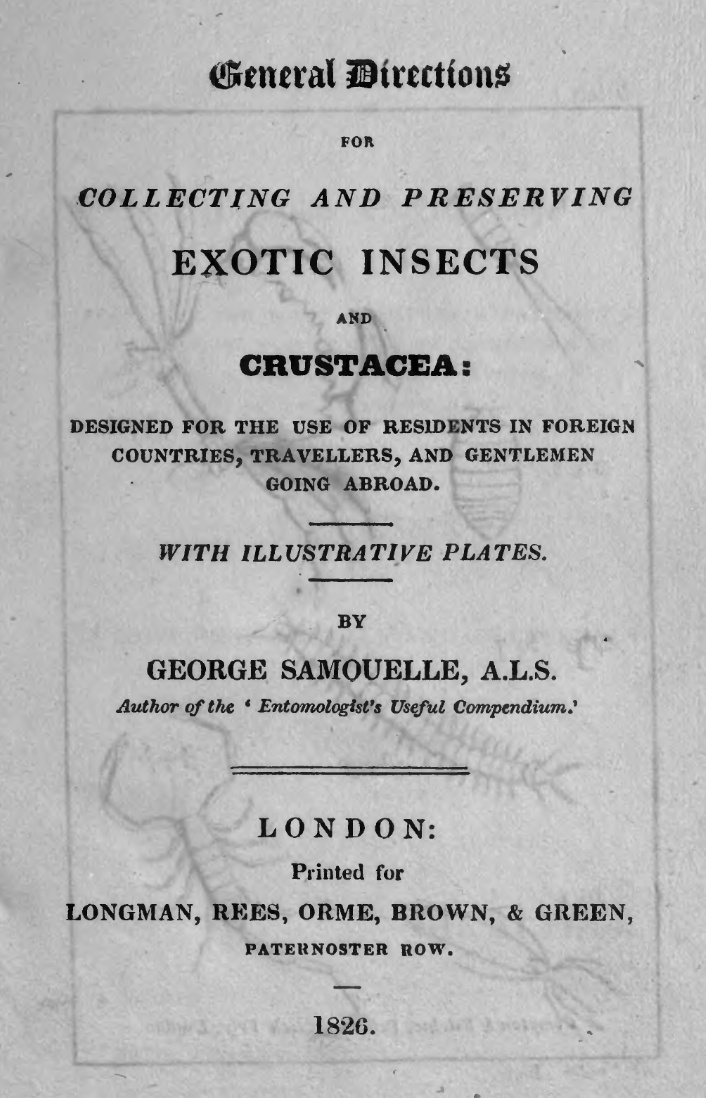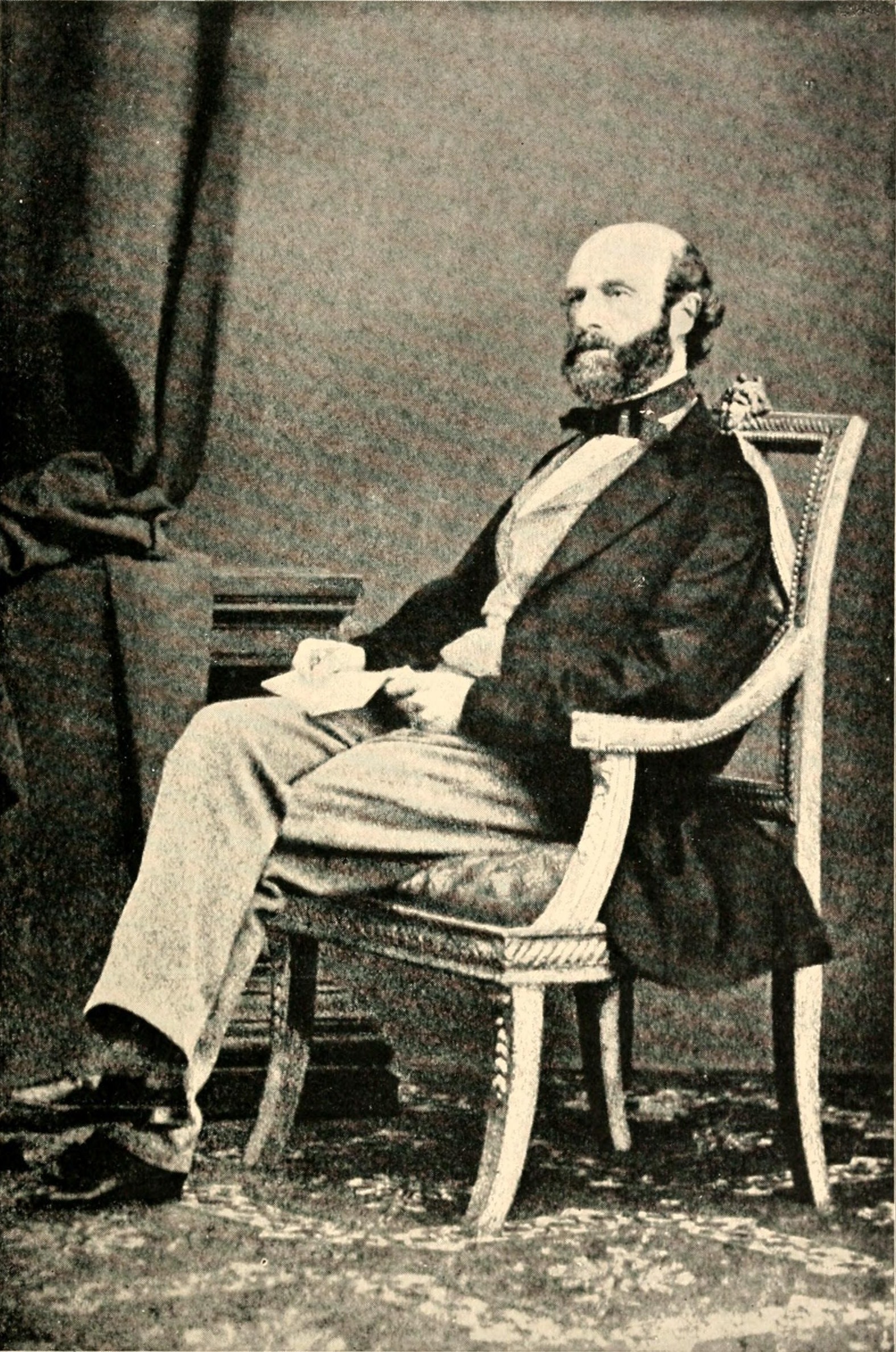|
George Thomas Rudd
George Thomas Rudd (c.1795 - 4 March 1847)M. Lawson Thompson, Report on the Coleoptera observed in Cleveland' in Proceedings of the Cleveland Naturalists Field Club 1903-04, p. 186. was an English priest and entomologist mainly interested in Coleoptera. Rudd was probably born in North Yorkshire 1794 or 1795. He studied at St John's College, Cambridge, where he got a B.A. before 1818 and a M.A. before 1821. He was ordained as deacon in 1818 and as priest in 1819 by John Fisher. He served as curate at Horsted Keynes (West Sussex) from 1818, at Shipton Bellinger (Hampshire) from 1819, and at Kimpton (Hampshire) from 1821. In 1833 he was appointed vicar of Sockburn (North Yorkshire),Rudd, George Thomas (1818 - 1833) at |
James Francis Stephens
James Francis Stephens (16 September 1792 – 22 December 1852) was an English entomologist and naturalist. He is known for his 12 volume ''Illustrations of British Entomology'' (1846) and the ''Manual of British Beetles'' (1839). Early life Stephens was born in Shoreham-by-Sea and studied at Christ's Hospital. His father was a navy captain William James Stephens (d. 1799) and his mother was Mary Peck (later Mrs Dallinger). He went to school at the Blue Coat School, Hertford and later at Christ's Hospital, London. He was then sent to study under Shute Barrington (1734–1826), the bishop of Durham in 1800. He left in 1807 and worked as a clerk in the Admiralty office, Somerset House, from 1807 to 1845 thanks to his uncle Admiral Stephens. Entomology Stephens took an interest in natural history even as a schoolboy. He wrote a manuscript ''Catalogue of British Animals'' in 1808. He was elected fellow of the Linnean Society on 17 February 1815, and of the Zoological Society o ... [...More Info...] [...Related Items...] OR: [Wikipedia] [Google] [Baidu] |
1847 Deaths
Events January–March * January 4 – Samuel Colt sells his first revolver pistol to the U.S. government. * January 13 – The Treaty of Cahuenga ends fighting in the Mexican–American War in California. * January 16 – John C. Frémont is appointed Governor of the new California Territory. * January 17 – St. Anthony Hall fraternity is founded at Columbia University, New York City. * January 30 – Yerba Buena, California, is renamed San Francisco. * February 5 – A rescue effort, called the First Relief, leaves Johnson's Ranch to save the ill-fated Donner Party (California-bound emigrants who became snowbound in the Sierra Nevada earlier this winter; some have resorted to survival by cannibalism). * February 22 – Mexican–American War: Battle of Buena Vista – 5,000 American troops under General Zachary Taylor use their superiority in artillery to drive off 15,000 Mexican troops under Antonio López de Santa Anna, defeating the Mexicans the next day. * ... [...More Info...] [...Related Items...] OR: [Wikipedia] [Google] [Baidu] |
1790s Births
Year 179 ( CLXXIX) was a common year starting on Thursday (link will display the full calendar) of the Julian calendar. At the time, it was known as the Year of the Consulship of Aurelius and Veru (or, less frequently, year 932 ''Ab urbe condita''). The denomination 179 for this year has been used since the early medieval period, when the Anno Domini calendar era became the prevalent method in Europe for naming years. Events By place Roman empire * The Roman fort Castra Regina ("fortress by the Regen river") is built at Regensburg, on the right bank of the Danube in Germany. * Roman legionaries of Legio II ''Adiutrix'' engrave on the rock of the Trenčín Castle (Slovakia) the name of the town ''Laugaritio'', marking the northernmost point of Roman presence in that part of Europe. * Marcus Aurelius drives the Marcomanni over the Danube and reinforces the border. To repopulate and rebuild a devastated Pannonia, Rome allows the first German colonists to enter territory con ... [...More Info...] [...Related Items...] OR: [Wikipedia] [Google] [Baidu] |
English Entomologists
English usually refers to: * English language * English people English may also refer to: Peoples, culture, and language * ''English'', an adjective for something of, from, or related to England ** English national identity, an identity and common culture ** English language in England, a variant of the English language spoken in England * English languages (other) * English studies, the study of English language and literature * ''English'', an Amish term for non-Amish, regardless of ethnicity Individuals * English (surname), a list of notable people with the surname ''English'' * People with the given name ** English McConnell (1882–1928), Irish footballer ** English Fisher (1928–2011), American boxing coach ** English Gardner (b. 1992), American track and field sprinter Places United States * English, Indiana, a town * English, Kentucky, an unincorporated community * English, Brazoria County, Texas, an unincorporated community * Engli ... [...More Info...] [...Related Items...] OR: [Wikipedia] [Google] [Baidu] |
York
York is a cathedral city with Roman origins, sited at the confluence of the rivers Ouse and Foss in North Yorkshire, England. It is the historic county town of Yorkshire. The city has many historic buildings and other structures, such as a minster, castle, and city walls. It is the largest settlement and the administrative centre of the wider City of York district. The city was founded under the name of Eboracum in 71 AD. It then became the capital of the Roman province of Britannia Inferior, and later of the kingdoms of Deira, Northumbria, and Scandinavian York. In the Middle Ages, it became the northern England ecclesiastical province's centre, and grew as a wool-trading centre. In the 19th century, it became a major railway network hub and confectionery manufacturing centre. During the Second World War, part of the Baedeker Blitz bombed the city; it was less affected by the war than other northern cities, with several historic buildings being gutted and restore ... [...More Info...] [...Related Items...] OR: [Wikipedia] [Google] [Baidu] |
Yorkshire Museum
The Yorkshire Museum is a museum in York, England. It was opened in 1830, and has five permanent collections, covering biology, geology, archaeology, numismatics and astronomy. History The museum was founded by the Yorkshire Philosophical Society (YPS) to accommodate their geological and archaeological collections, and was originally housed in Ousegate, York, until the site became too small. In 1828, the society received by royal grant, of land formerly belonging to St Mary's Abbey for the purposes of building a new museum. The main building of the museum is called the Yorkshire Museum; it was designed by William Wilkins in a Greek Revival style and is a Grade I listed building. It was officially opened in February 1830, which makes it one of the longest established museums in England. A condition of the royal grant was that the land surrounding the museum building should be a botanic gardens and one was created in the 1830s. The botanic gardens are now known as the Museum G ... [...More Info...] [...Related Items...] OR: [Wikipedia] [Google] [Baidu] |
Royal Entomological Society
The Royal Entomological Society is devoted to the study of insects. Its aims are to disseminate information about insects and improving communication between entomologists. The society was founded in 1833 as the Entomological Society of London. It had many antecedents beginning as the Society of Entomologists of London. History The foundation of the society began with a meeting of "gentlemen and friends of entomological science", held on 3 May 1833 in the British Museum convened by Nicholas Aylward Vigors with the presidency of John George Children. Those present were the Reverend Frederick William Hope, Cardale Babington, William Yarrell, John Edward Gray, James Francis Stephens, Thomas Horsfield, George Thomas Rudd and George Robert Gray. Letters of Adrian Hardy Haworth, George Bennett and John Curtis were read where they expressed their regrets to be unable to attend the meeting. They decided that a society should be created for the promotion of the science of entomology ... [...More Info...] [...Related Items...] OR: [Wikipedia] [Google] [Baidu] |
Entomological Society Of London
The Royal Entomological Society is devoted to the study of insects. Its aims are to disseminate information about insects and improving communication between entomologists. The society was founded in 1833 as the Entomological Society of London. It had many antecedents beginning as the Society of Entomologists of London. History The foundation of the society began with a meeting of "gentlemen and friends of entomological science", held on 3 May 1833 in the British Museum convened by Nicholas Aylward Vigors with the presidency of John George Children. Those present were the Reverend Frederick William Hope, Cardale Babington, William Yarrell, John Edward Gray, James Francis Stephens, Thomas Horsfield, George Thomas Rudd and George Robert Gray. Letters of Adrian Hardy Haworth, George Bennett and John Curtis were read where they expressed their regrets to be unable to attend the meeting. They decided that a society should be created for the promotion of the science of entomolog ... [...More Info...] [...Related Items...] OR: [Wikipedia] [Google] [Baidu] |
Linnean Society
The Linnean Society of London is a learned society dedicated to the study and dissemination of information concerning natural history, evolution, and taxonomy. It possesses several important biological specimen, manuscript and literature collections, and publishes academic journals and books on plant and animal biology. The society also awards a number of prestigious medals and prizes. A product of the 18th-century enlightenment, the Society is the oldest extant biological society in the world and is historically important as the venue for the first public presentation of the theory of evolution by natural selection on 1 July 1858. The patron of the society was Queen Elizabeth II. Honorary members include: King Charles III of Great Britain, Emeritus Emperor Akihito of Japan, King Carl XVI Gustaf of Sweden (both of latter have active interests in natural history), and the eminent naturalist and broadcaster Sir David Attenborough. History Founding The Linnean Society wa ... [...More Info...] [...Related Items...] OR: [Wikipedia] [Google] [Baidu] |
George Samouelle
George Samouelle (–1846) was a curator in the British Museum (Natural History) of "no real scientific aptitude". Originally employed as a bookseller for Longman & Co., Samouelle joined the Natural History Museum at the same time as William Elford Leach. Leach appears to have aided Samouelle greatly, with Bate & Westwood stating "Dr. Leach is the principal authority for Samouelle's work"; when Leach left the museum, Samouelle took over his position, but he "seemed incapable of independent work". Twenty years later, in 1840, after neglecting his work, drinking, insulting his superiors, and on one occasion, removing the labels from Adam White's specimens, Samouelle was sacked. He died less than five years later. Samouelle was primarily interested in Lepidoptera but also wrote ''A nomenclature of British Entomology, or a catalogue of above 4000 species of the Classes Crustacea, Myriapoda, Spiders, Mites and insects intended as labels for cabinets of Insects, etc., alphabetically a ... [...More Info...] [...Related Items...] OR: [Wikipedia] [Google] [Baidu] |
Alexander Henry Haliday
Alexander Henry Haliday (1806–1870, also known as Enrico Alessandro Haliday, Alexis Heinrich Haliday, or simply Haliday) was an Irish entomologist. He is primarily known for his work on Hymenoptera, Diptera, and Thysanoptera, but worked on all insect orders and on many aspects of entomology. Haliday was born in Carnmoney, Co. Antrim later living in Holywood, County Down, Ireland. A boyhood friend of Robert Templeton, he divided his time between Ireland and Lucca, where he co-founded the Italian Entomological Society with Camillo Rondani and Adolfo Targioni Tozzetti. He was a member of the Royal Irish Academy, the Belfast Natural History Society, the Microscopical Society of London, and the Galileiana Academy of Arts and Science, as well as a fellow of the (now Royal) Entomological Society of London. Alexander Haliday was among the greatest dipterists of the 19th century and one of the most renowned British entomologists. His achievements were in four main fields: desc ... [...More Info...] [...Related Items...] OR: [Wikipedia] [Google] [Baidu] |





.jpg)

